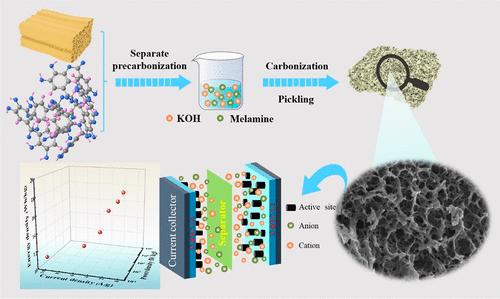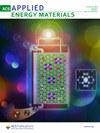从单宁酸和芦苇秆中提取的氮氧共掺层多孔碳用于高性能超级电容器
IF 5.4
3区 材料科学
Q2 CHEMISTRY, PHYSICAL
引用次数: 0
摘要
有效利用丰富的天然生物质衍生材料作为开发高性能电极的可持续前驱体,对于推进超级电容器的实际应用具有重要意义。在本研究中,我们提出了一种有效的策略,即通过 KOH 和三聚氰胺(MA)的共化学活化以及预碳化,将生物质芦苇秆和单宁酸(TA)作为双重碳源转化为具有丰富微/介孔互连层状结构的 N、O 共掺分层多孔碳电极材料,命名为 N-RTC-1.5。N-RTC-1.5 具有独特的蜂窝状多孔结构,比表面积高达 2545 m2/g。作为超级电容器电极,在三电极系统中,N-RTC-1.5 在 1 A/g 时的比电容高达 366.0 F/g。此外,N-RTC-1.5//N-RTC-1.5 对称超级电容器的能量密度达到 18.32 Wh/kg,在 3 A/g 条件下循环 10000 次后,电容保持率约为 96%。这项研究为将生物质转化为高性能超级电容器电极所需的新型碳材料提供了一种简单、可持续和环保的方法。本文章由计算机程序翻译,如有差异,请以英文原文为准。

Nitrogen and Oxygen Codoped Hierarchically Porous Carbon Derived from Tannic Acid and Reed Straw for High-Performance Supercapacitors
The effective utilization of abundant natural biomass-derived materials as sustainable precursors for developing high-performance electrodes is of great significance for advancing practical applications of supercapacitors. In this study, we propose an effective strategy to convert biomass reed straw and tannic acid (TA) as dual carbon sources into N, O codoped hierarchically porous carbon electrode materials with a rich micro/mesoporous interconnected layered structure, denoted as N-RTC-1.5, through cochemical activation of KOH and melamine (MA) and precarbonization. N-RTC-1.5 exhibits a unique honeycomb-like porous structure with a high specific surface area of up to 2545 m2/g. As a supercapacitor electrode, N-RTC-1.5 demonstrates an excellent specific capacitance of 366.0 F/g at 1 A/g in a three-electrode system. Furthermore, the energy density of an N-RTC-1.5//N-RTC-1.5 symmetric supercapacitor reaches 18.32 Wh/kg, and after 10000 cycles at 3 A/g, the capacitance retention is approximately 96%. This research provides a simple, sustainable, and environmentally friendly approach to convert biomass into novel carbon materials required for high-performance supercapacitor electrodes.
求助全文
通过发布文献求助,成功后即可免费获取论文全文。
去求助
来源期刊

ACS Applied Energy Materials
Materials Science-Materials Chemistry
CiteScore
10.30
自引率
6.20%
发文量
1368
期刊介绍:
ACS Applied Energy Materials is an interdisciplinary journal publishing original research covering all aspects of materials, engineering, chemistry, physics and biology relevant to energy conversion and storage. The journal is devoted to reports of new and original experimental and theoretical research of an applied nature that integrate knowledge in the areas of materials, engineering, physics, bioscience, and chemistry into important energy applications.
 求助内容:
求助内容: 应助结果提醒方式:
应助结果提醒方式:


